The technique of Bulgarian cross stitch embroidery originated in ancient times. Initially, this technology was used to create items whose back side was closed during use. These were pillows, pincushions, souvenirs, tablecloths. Bulgarian cross embroidery of clothing items (belts, aprons) had a symbolic meaning and served as a talisman for the owner.
What is a Bulgarian cross stitch in embroidery, what does it look like
Today, the Bulgarian cross has become less popular in embroidery. Craftswomen know it under such names as "snowflake" or "star". This embroidery looks decorative and voluminous, so it looks great in ornaments. The Bulgarian cross consists of two crossed crosses, so in the old days it was often called a "double" cross.
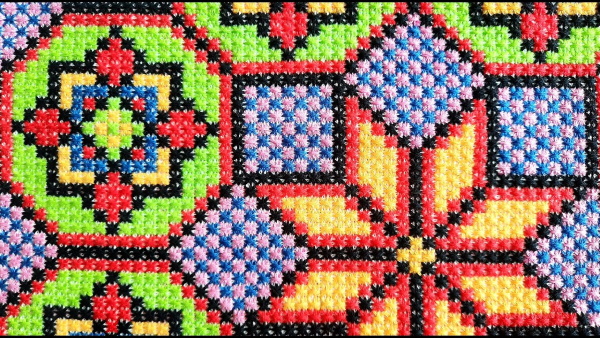
It received the name “Bulgarian” due to its prevalence: it was in Eastern Europe that this type of embroidery was widespread.
Where is the pattern most often used?
Bulgarian cross stitch embroidery (the technology of its creation is not complicated, you can quickly get used to it) is often used when embroidering decorative pillows, bedspreads and tablecloths. New Year's toys made in this technique also look great. Craftswomen often use the stitch when embroidering landscapes, where, due to the volume, the image looks unusual and multifaceted. This stitch looks beautiful in icons and when embroidering bouquets.
Advantages of using Bulgarian cross stitch in embroidery:
- the image density increases, the created item looks brighter and more impressive;
- A product made with a Bulgarian cross becomes similar to a tapestry or a carpet, due to the fact that the gaps between the crosses are filled as much as possible and the density of the fabric increases.
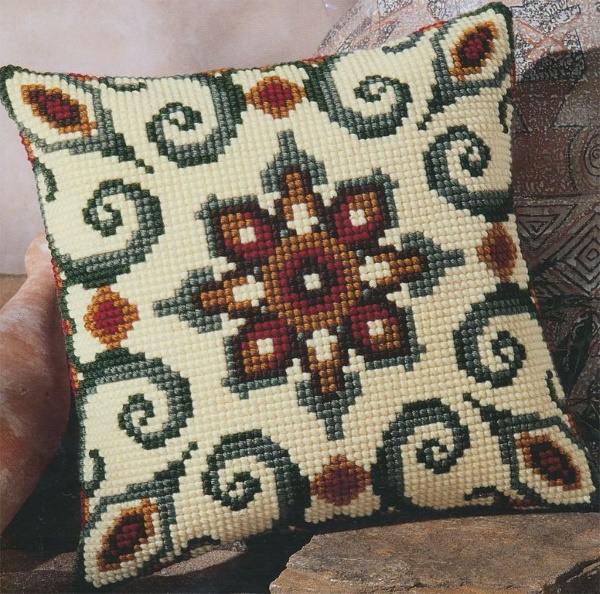
The Bulgarian cross is best used to embroider patterns consisting of geometric patterns; the use of a large number of bright colors and shades will allow the beauty of the product to be revealed to the fullest and emphasize its uniqueness.
Such embroidery gives a special look to the national costume and its elements (belt, apron, headdress, etc.). The Bulgarian national costume has always been abundantly decorated with bright embroidery. These were not only belts, but also cuffs, collars and hems of skirts. Some patterns in national costumes have a symbolic character and are used even now.
How to embroider with Bulgarian cross, step by step instructions
To master the technique of Bulgarian cross stitch embroidery, it is not necessary to attend special courses.
Fabrics for work
For embroidery in the Bulgarian cross technique, you need to buy some materials. First of all, you should choose the right fabric. It should consist of the same number of longitudinal and transverse threads. Such fabric should not be too thin, because the double cross embroidery itself is dense, so the fabric may come apart and the pattern will be damaged.
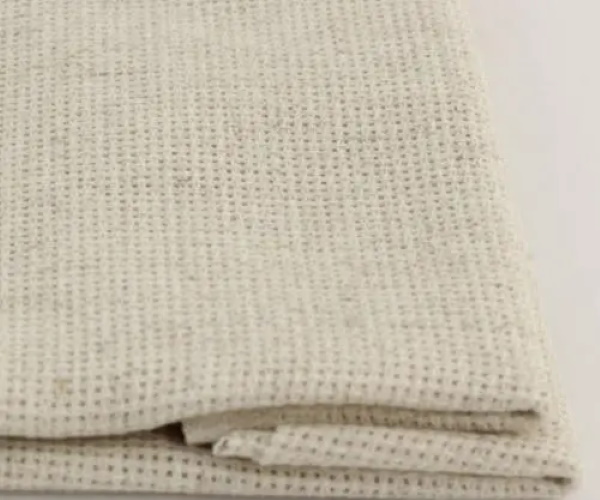
You can embroider on cotton fabric similar to calico, but it is not recommended on synthetic fabrics, as the material will stretch and the embroidery will deform. Bulgarian cross stitch embroidery (the technology is quickly mastered even by beginners) is easily transferred to linen. The difficulty is that the squares will have to be calculated according to the weaving threads. But embroidery on linen looks very neat and harmonious.
Linen is an excellent material for tablecloths, napkins, aprons and various decorative elements made in this technique. You can also embroider directly on canvas, the best of which at the moment is "Aida". Thanks to the clearly fixed weave, consisting of 3-4 threads, it forms peculiar cells, which are much easier to embroider on.
Canvas comes in different types:
- large – 20-30 crosses per inch (2.54 cm);
- small – 10-20 crosses per inch.
For the Bulgarian cross, a large canvas is better, with about 30 squares per 10 cm. An ordinary cross looks more elegant on a small canvas, but a large canvas allows the pattern of the Bulgarian cross to "open up", while on a small one it will not look so beautiful. For this type of fabric, where it is difficult to determine the number of threads in a certain length, a special canvas is used - an overlay, or it is also called removable.
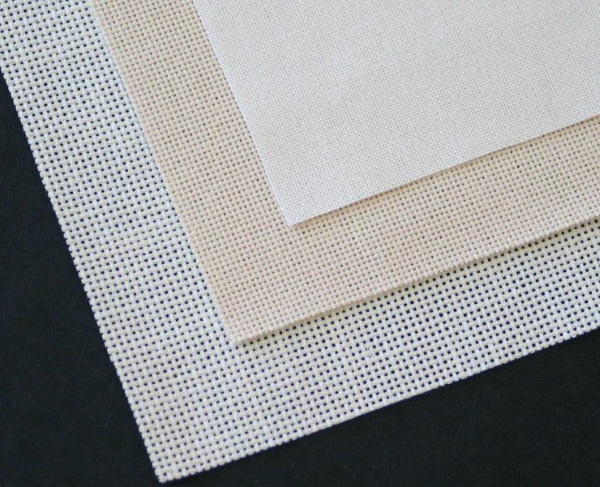
For embroidery on clothing items, such canvas is carefully sewn to the fabric and after the embroidery is completed, it is unraveled thread by thread, and the pattern remains the same and is not damaged. The overlay canvas differs from the standard canvas in density: the canvas threads are thicker, and the holes are wider than on any other canvas. Sometimes there is a special marking on the canvas, as a rule, it is done with a blue thread every 10 cells.
Another type of canvas is stramin, it is the stiffest of all types and for this reason it is used for embroidering pillows, bags, carpets. It is better to embroider on stramin with woolen threads.
In addition to all the listed types of fabric, perforated paper is used for embroidery. Embroidering on it is much more difficult than on canvas, because the paper is not as flexible and tears. Postcards and bookmarks are embroidered on it, using simple patterns with a minimal color palette.
In addition to the fabric, embroidery hoops are also important. They can be round, built on the basis of 2 hoops and a screw, allowing you to stretch the fabric between them as conveniently as possible for needlework. Also, hoops can be square or rectangular, but these 2 types are not so popular.
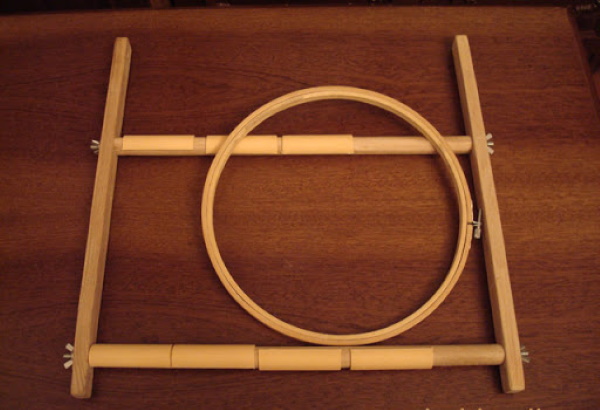
They can be made from:
- plastics;
- gland;
- trees.
Wooden hoops are considered the best.
Threads, needles for embroidery
An integral part of any handicraft is high-quality materials. In embroidery, they largely determine how the product will look at the end of the work. Experienced craftswomen advise not to skimp on the selection of necessary tools so that the process of creating a product does not cause irritation.
Needles
The most important material for embroidery is the needle, for this reason it is worth paying attention to its correct selection. For Bulgarian cross stitch, a tapestry needle with a blunt end is better. A sharp needle damages the canvas and the already embroidered part of the work, splitting it into threads. Another feature of needles for cross stitch is a wide eye, into which you can thread any thickness, be it wool or floss in several folds.
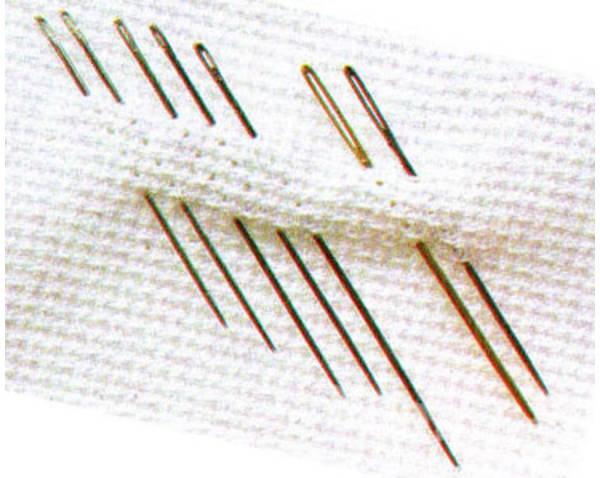
All embroidery needles are selected to match the canvas and are available in different sizes:
| Canvas | Needle number |
| Aida 8 | №20, 22 |
| Aida 11 | №22, 24 |
| Aida 14 | №22, 24, 26 |
| Aida 18 | №24, 26 |
| Aida 20 | №24, 26 |
| Hardanger 22 | №28 |
There are also double-ended needles, the eye of which is located in the middle. With such needles, you can embroider using two hands: one is located on the hoop, the other under it. Thanks to this technique, you do not have to turn over the embroidery each time and do needlework with greater comfort.
Today, embroidery almost always uses floss threads specially designed for this purpose. They are produced by both global brands (Madeira, Ankor) and Russian companies (Gamma). Floss is usually sold in small packages of 8-20 m. A beginner in embroidery should know that each manufacturer has its own color palette, so when creating embroidery, it is better to use floss of one brand.
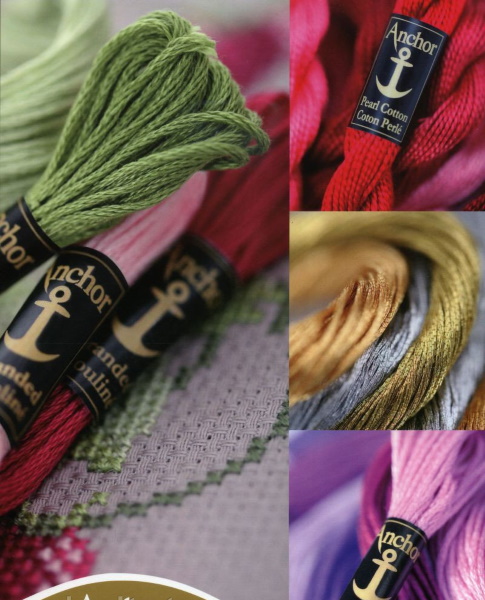
In stores, as a rule, all products are presented in catalogs with samples, thanks to which it is much easier to choose the right shade of thread. In addition to standard colors, some manufacturers have melange threads, with a transition from one shade to another and even metallic color.
After purchasing threads, before you start embroidering, it is better to check whether the threads will shed. To do this, wet the colored thread and run it over the white fabric. If the fabric remains clean, the threads will not shed even after washing the entire product.
In addition to the listed materials, the embroidery process will require:
- scissors (one large to cut the fabric and one small to cut the ends of the thread);
- markers (washable ones are convenient for dividing the canvas into large cells, and disappearing ones are used to mark the necessary places on the embroidery);
- eraser by fabric (it will help you make markings on the fabric and, unlike a pencil, you can simply remove it).
Step-by-step technology of Bulgarian cross stitch
The Bulgarian cross stitch (the technology is quickly mastered) consists of 2 intersecting crosses. First, a regular cross is made from the bottom and from left to right, then a straight cross is embroidered on top of it.
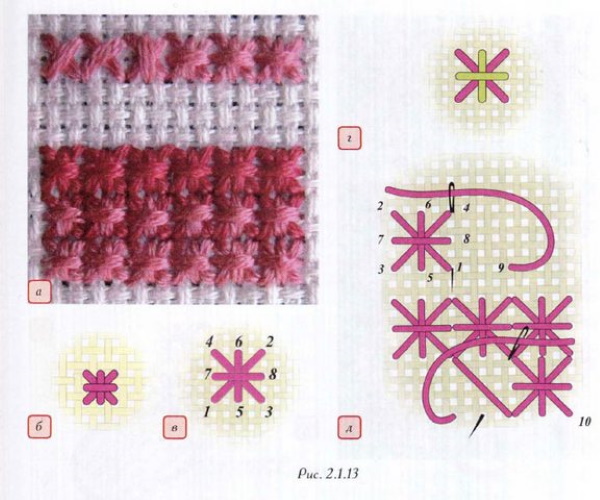
The embroidery technique can be presented as follows:
- it is necessary to select a cell on the canvas that will serve as the beginning of the embroidery;
- the thread needs to be secured on the wrong side and from the lower left corner of the cell make a “step” with the needle up and to the right;
- on the reverse side of the canvas, the needle, located in the upper right corner, moves to the upper left corner, and then to the lower right;
- on the back side of the work, the needle is moved from the lower right corner to the center of the cell, to its lower border, to where the diagonal stitches intersect and forms a horizontal stitch (the needle is inserted strictly vertically);
- from the back side, the needle is brought out through the top point and passes to the left, to the center of the right point on the cell, while the thread forms another horizontal stitch;
- the needle is brought out to the lower right corner;
- As a result of all manipulations, you should get a snowflake - the main element of embroidery.
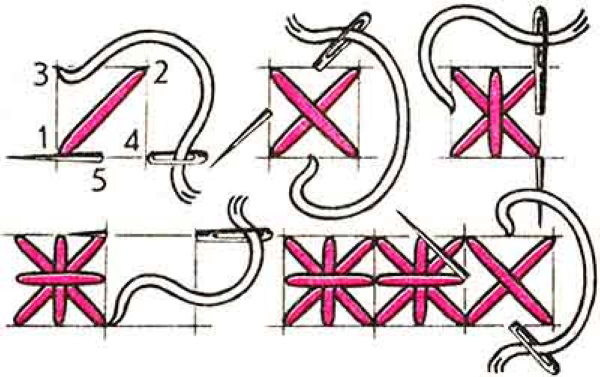
The Bulgarian cross embroidery (the technology allows you to embroider the cross in different sequences, changing the direction of the needle depending on how it is more convenient for the craftswoman to embroider) remains unchanged when changing the direction of the game insertion into the fabric.
Tips and tricks for work
For those who are just getting acquainted with Bulgarian cross stitch, it will be useful to learn some secrets of successful needlework:
- Before starting work, it is always necessary to wash your hands, because the canvas on which the product will be embroidered is very light, and in 1-2 months, or even half a year, that the work will be embroidered, it will absorb quite a lot of dust and dirt. The product can be washed only after the embroidery is finished. Moreover, machine washing is strictly contraindicated for embroidered works.
- To prevent your work from gathering dust, if your breaks in embroidery are too long, you can either hide it in a cover, which can be easily made yourself from a small piece of fabric, or simply cover it with a clean cloth.
- To prevent the edges of the canvas from fraying, you can buy special covers or make them yourself. For round hoops, you can take any lightweight, single-color fabric, sew a donut out of it, and attach a linen elastic band to both edges.
- It is better to embroider in good lighting; you can illuminate the work area directly with a floor lamp or a clothespin lamp.
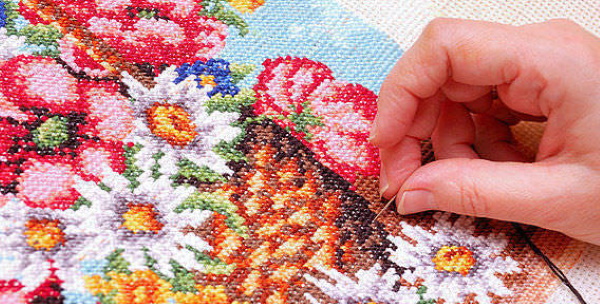
- During the embroidery process, it is important to ensure that the crosses are even and that the entire embroidery is not pulled tight. To do this, you can not completely tighten the thread of the cross during the work, leaving it a little loose. This will give the picture an interesting volume, and the work itself will look neater.
- It is important that all the crosses are made the same, that is, the topmost cross should match the entire image. Therefore, having chosen a convenient execution of the "Bulgarian cross" technique, you should embroider all the elements in the same sequence.
- To make the embroidery look neat from the back side, it is better to secure it without knots. So at the beginning of the embroidery, you can do this with a loop, and at the end, pass the thread along the back side under the finished cross. If you can’t do without a knot, you should make it as small as possible.
- When embroidering different fragments of the work with one color, do not make long pulls. Firstly, they will pull the entire embroidery, and secondly, this is a big waste of thread. It is better to carefully secure the thread and cut it, as stated in the previous paragraph.
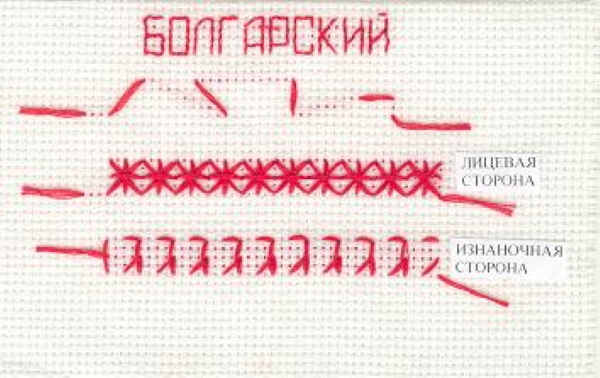
- To begin with, it is better to choose simple plots with as few small details as possible. It is also worth giving preference to small-sized works, since their creation will take little time and embroidery will not have time to get boring.
Bulgarian cross stitch patterns
In Bulgarian cross stitch, it is better to try your hand at small things. For example, following the technology, you can embroider a pincushion in a floral style.
To create it you will need:
- canvas (small square 10x10 cm);
- scissors;
- scheme;
- embroidery needle that matches the canvas;
- floss threads.
For embroidery you will need threads of the following shades:
- dark green and light green;
- cornflower blue;
- indigo;
- blue;
- lilac;
- yellow.
If desired, you can select threads in a different color range.

Making a sofa cushion will require more skill and patience than making a simple small napkin.
The materials you will need are:
- a piece of canvas 50x50 cm, you can use soluble canvas and the main fabric for the pillow should be the same for both sides;
- round or square hoop;
- scissors;
- scheme;
- marker for highlighting the necessary areas of work;
- embroidery needle;
- threads of yellow, light green, lilac, orange, red and light brown colors.
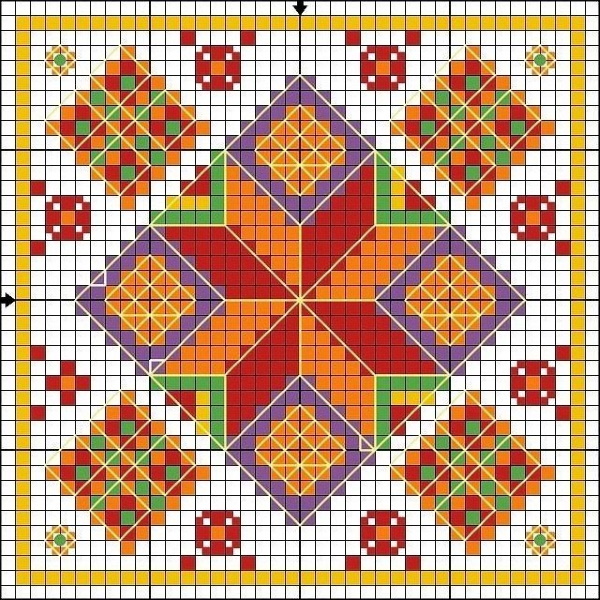
You can decorate a blouse or skirt in ethnic style with embroidery. Simple patterns consisting of several colors are used for this.
To embroider a floral motif you will need:
- canvas, which can be unraveled after embroidery, is sewn onto those areas of clothing where the design is planned to be placed;
- hoop;
- scheme;
- scissors;
- floss threads in dark and light green, orange, peach, white and brown shades.
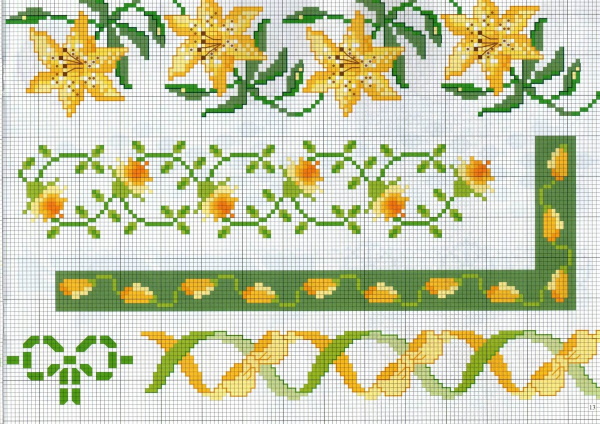
Ready.
How to care for embroidery
To ensure that embroidered items decorate your interior for as long as possible, they require proper care:
- The embroidery is washed by hand, using a gentle detergent without chlorine. A liquid detergent is better for this purpose. The water should be slightly warm, no more than 40-45˚. First, the product is soaked and after 15-20 minutes, carefully washed, and then rinsed in cold water.
- The embroidery should be dried horizontally, for this you can place it on the table, having previously placed a towel on it. You can make a roller out of the towel, rolling the embroidery into it, so it will dry faster and will not deform.
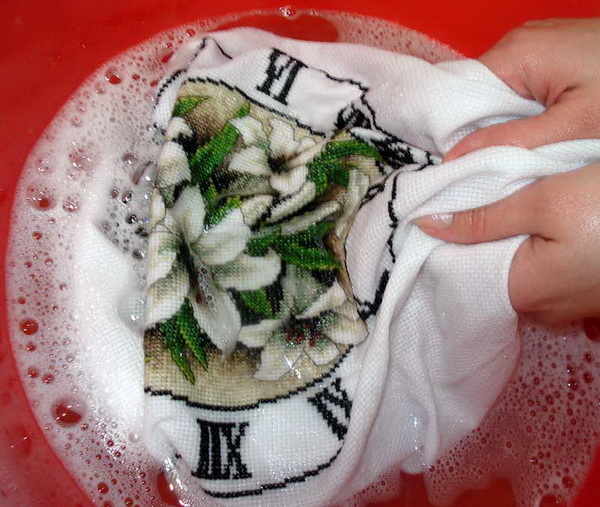
- As the product dries, you can steam it through gauze or cotton fabric, but only from the inside. Thanks to this procedure, the product will not lose its shape and color.
- When working on water-soluble canvas, you can only use high-quality, color-stable floss that will not fade at 50˚ (the temperature at which the canvas dissolves).
- Before washing the embroidery, it is better to treat the edges of the canvas with clear varnish or PVA glue to prevent them from unraveling.
- It is better to store embroidered items separately from others, in a specially designated section of the closet, or in a separate storage container. You can arrange all the decor thematically, depending on its use at different times of the year.
Bulgarian cross stitch embroidery is popular today and looks great in different interiors, be it boho or Provence. The technology of its creation is simple, so every craftswoman can master it.
Video about Bulgarian cross stitch
How to embroider with Bulgarian cross stitch:
